5 reasons why your next business PC should be a small PC
Small, powerful and quiet, what's not to like?
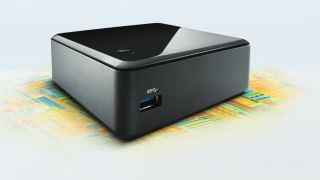
All about the NUCs
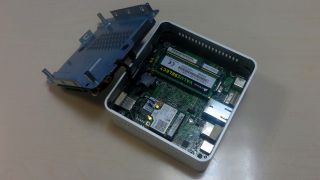
When it comes to business, computers have often been slammed for being boring and conservative. Change is coming however as Intel's NUC is the latest to position itself in the minds of decision makers within IT departments as a viable replacement for standard desktop sized personal computers.
Small enough to fit in the palm of your hand but cramming enough juice and features to satisfy any office user, NUCs are likely to become a common sight in the business world in the coming years.
Initially launched in 2013, the NUC now sits between the diminutive Compute Stick and larger desktops and laptops. While the earlier models were very much geared towards tinkerers and enthusiasts, eager to build bespoke computers that fit their needs, the newer breed of NUCs are more than capable of handling business needs with ease.
Intel also added some nifty enterprise features on some models which make them ideal as drop-in replacement for ageing fleets of desktops. What's more, with the cloud becoming central to businesses and power requirements from software plateauing, they could be the biggest beneficiaries of this incredibly tiny computer.
Simplified management
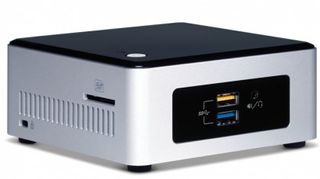
In its simplest form, the NUC could be considered as a discrete unit of computing, one that can be easily replaced, often by the user itself. Given its size, it is easy to store 12 of these, locked in a drawer; no need to requisition a whole room as it would have been the case for the equivalent standard form factor, desktop computers.
In addition, because Intel has prioritised modularity, replacing faulty, serviceable parts (RAM, storage) can be done within minutes. In the case of the NUC's power supply unit, anyone who can charge a mobile phone should be able to change it.
And because NUCs use parts that are commonly found in laptops, it makes stock management easier if you have a fleet of standard, user-serviceable laptops and NUCs as they may share the same components (system memory and SSD/hard drive).
Are you a pro? Subscribe to our newsletter
Sign up to the TechRadar Pro newsletter to get all the top news, opinion, features and guidance your business needs to succeed!
Compact yet powerful
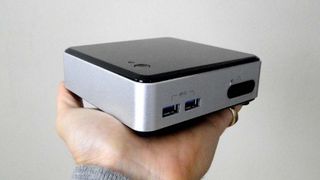
The NUC was designed from the start as being a compressed version of the PC. Intel managed to cut the size of the latest models to well under a pint (0.568L); the NUC5i3RYK occupies a volume barely bigger than a standard can of fizzy drinks (0.34L) and is actually similar in size to some processor heatsinks on the market.
Speaking of which, the ones on NUCs are significantly quieter because Intel handpicked low-power processors, build using the latest technologies, those that can provide a lot of firepower while dissipating a minimal amount of power.
In turn, that helps lower power bills across companies, which in turn impacts positively by the total cost of ownership (TCO).
Workstation capabilities as standard

Just because the NUC is small doesn't mean that it is not a fully featured device. Most of the newer models can support up to 16GB of RAM with a powerful Intel Core i7 processor with an Iris Graphics 6100 solution at its heart. Recent models even offer RAID-0 and RAID-1 options allowing users to choose between a faster workstation and added redundancy.
The onboard connection options are more than decent. Most NUCs have a GbE Ethernet ports and those who have Wi-Fi usually carry the Wireless-AC model paired with Bluetooth 4.0. As for display, the majority of NUCs can output to three monitors with some models supporting up to 4K via DisplayPort.
Should the six USB ports onboard not be enough for users' needs, M.2 slots and Half-length MiniPCI slots are available on many models for added expansion capabilities.
If that wasn't enough, some NUCs cater for legacy applications with VGA connectors and serial ports (via internal header). Intel also made it easy for companies to add more customisable features by providing functional replaceable lids which adds new functionality.
That includes wireless charging, near field communication and even 4G/LTE wireless connectivity. The possibilities are endless and Intel even gives you the blueprints so you can design and produce your own lids.
Built for BYOD
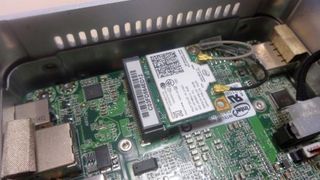
The NUC makes it far easier for companies and employees to embrace BYOD (Bring-your-own-device) with minimal disruption. Put it this way, if you want to carry your computer either because you commute frequently or work from home regularly, then the NUC is the perfect solution.
It takes only a matter of seconds to disconnect the unit from its power supply unit, a monitor and input peripherals due to its design. Also as the NUC uses resilient components usually found in laptops, it resists shocks better and is much lighter than carrying a laptop around; some can easily fit in a jacket pocket.
The other aspect of BYOD as a remote worker is the fact that it has some pretty consumer-friendly features. That includes HDMI connectivity, 7.1 digital audio, consumer infrared headers and on one model, SPDIF Out/TOSLINK connector. Plus it does help that the NUC is a nice looking piece of kit.
Boosts TCO

Intel has deployed its vPro technology on some models (DC53427HYE and NUC5i5MYHE); this is a set of security and manageability capabilities built into the processor itself and aimed at addressing critical areas of IT security.
The same models can also take advantage of the optional Small Business Advantage. SBA, as it is known, gives small businesses out-of-the-box features to enhance security and productivity of their small businesses.
Intel also provides with nifty features like support for Wireless Display (Wi-Di) and Wi-Fi as well as up to a three-year warranty with many models. All of this is geared towards making deployment of the device within any companies as painless as possible.
Because the NUC is still a PC, it benefits from the wide network of support from Intel's ISVs (Independent Software Vendors) and VAR (Value Added Resellers).
- For more information on the Intel NUC product range please visit: http://www.intel.co.uk/content/www/uk/en/nuc/overview.html

Désiré has been musing and writing about technology during a career spanning four decades. He dabbled in website builders and web hosting when DHTML and frames were in vogue and started narrating about the impact of technology on society just before the start of the Y2K hysteria at the turn of the last millennium.
